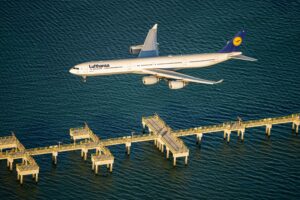Stepping on the scale can be stressful. So can air travel. Now imagine needing to weigh yourself before you can board your next flight.
That’s what Korean Air travelers flying domestically through Seoul’s Gimpo International Airport (GMP) and Incheon International Airport (ICN) were set to experience after the airline announced it would weigh passengers with their carry-ons to measure the average weight of passengers.
But Korean Air faced such swift backlash that it ultimately took down a notice related to weighing passengers on its website just days after the announcement, according to CNBC.
Air New Zealand also made headlines in May for weighing its passengers departing from Auckland Airport (AKL) for international flights.
The practice — although controversial to many travelers — is actually fairly standard within the airline industry.
And there’s good news for those who may not be thrilled about having to see the scale: The airlines aren’t paying attention to each passenger’s individual weight, at least on most commercial jetliners. Instead, they’re looking for a real-world average so that they can better plan things like fuel use and cargo capacity.
Related: Korean Air becomes latest carrier to stop selling most first-class seats
Airlines may also occasionally weigh passengers so they can recalibrate the weight distribution of their aircraft in order for them to safely take off and land, according to Blaise Waguespack, a professor at Embry-Riddle Aeronautical University who specializes in airline marketing and operations.
“If you don’t have the right weight balance profile, a wrong gust of wind — boom, you’ll drag the tail,” he said.
Knowing how much weight an aircraft can handle can be important in situations where an aircraft is operating in an area with sweltering temperatures, for example.
Bob Thomas, an Embry-Riddle professor at the university’s aeronautical science department, said in areas that can get extremely hot, airlines may need to reduce the weight on their aircraft in order to take off.
“Most people don’t realize that the weight just doesn’t affect your actual take-off distance, but it also affects making sure that you can climb over obstacles afterwards,” Thomas said.
Related: Air New Zealand announces pricing for new in-flight sleep pods
Weighing passengers is especially common for airlines that operate smaller aircraft, where the individual weight of each passenger is actually more important.
“The issue of weighing passengers is that every airplane has a weight and balance program, whether you’re a small airplane or a big airplane,” Michael Suckow, a professor at Purdue University’s School of Aviation and Transportation Technology, said.
Suckow said airlines that fly planes like the smaller Bombardiers and Embraers might tend to weigh passengers more since the weight of passengers — along with fuel and equipment — can heavily affect the balance of the plane.
Related: The best airline credit cards
However, for larger airlines that operate aircraft like a Boeing or an Airbus, weighing passengers isn’t all that common. Instead, most airlines rely on surveys of a certain sample — like the samples that Korean Air and Air New Zealand obtained recently — to determine the average weight of passengers, according to Thomas.
In the U.S., airlines can also determine the weight distribution of planes from surveys conducted by the Centers for Disease Control and Prevention. The survey, known as the National Health and Nutrition Examination Survey, weighs a sample of U.S. residents, which airlines can then use to determine the average weight of a passenger.
Related: When is the best time to book flights for the cheapest airfare?
Even though U.S. airlines have other means to determine the average passenger weight, an advisory circular from the Federal Aviation Administration said airlines are allowed to weigh travelers at any given time.
It’s ultimately up to the carrier’s governmental airline regulators to determine how airlines figure out weight distribution.
So, some countries may require their carriers to have passengers step on a scale.
In the cases of Korean Air and Air New Zealand, they are following mandates from their respective countries that require them to periodically update their calculations for average passenger weight.
A Korean Air spokesperson said the carrier, along with other Korean airlines, was weighing passengers and their carry-ons to provide data to the country’s Ministry of Land, Infrastructure and Transport for its “Aircraft Weight and Balance Management Standards,” which are updated every five years.
Maximize your airfare: The best credit cards for booking flights
“This is a government mandate and is necessary for the safety of flight operations,” the spokesperson said.
Air New Zealand also reiterated that its weight surveys were a mandate from New Zealand’s Civil Aviation Authority.
“Our passenger weight survey was a mandatory Civil Aviation Authority requirement, participation was voluntary, and all data was completely anonymous, even to airline staff,” an Air New Zealand spokesperson said.
Read more: Expensive airfare and increasing gas prices: Here’s how you can save on holiday travel
And even if the practice may seem invasive, the weights of each individual passenger and their carry-on are typically kept anonymous — only the airline sees the total weight, and each passenger’s data is anonymized. Plus, passengers have the option to decline to participate in any weight surveys: Both Korean Air and Air New Zealand emphasized that travelers could opt out of their respective weight surveys.
It can feel unpleasant if an airline asks for your weight, but know that it is a customary practice.
“It’s definitely an awkward situation, an awkward conversation, an awkward request,” Suckow said. “But it is something that the carriers have to figure out how to do if asked by [regulatory authorities] to validate their program.”



